CPE Speaking Exam (C2 Proficiency) | Insightful Extended Guide
This overview of the Cambridge CPE speaking exam is essentially a sequel to my last post on how to attain proficiency in spoken English.
First of all, I will describe the format of the CPE speaking exam and other key questions candidates may have. Secondly, I will consider the three parts of the test and provide tips to navigate them. Thirdly, I’ll go over the assessment scales and marking criteria for the test. Fourthly, I’ll analyse a real CPE speaking exam. Finally, I’ll offer some advice about how best to prepare for the CPE speaking test.
Mục Lục
Key questions regarding the CPE speaking exam
1. What’s the format of the CPE speaking exam?
The CPE speaking exam lasts 16 minutes and consists of three parts.
Each section is designed to test different skills and demands a variety of interaction patterns.
The standard test format is two candidates and two examiners. It may happen that there’s an uneven number of candidates at an exam centre. In such a case, three candidates take the last speaking exam of the session. The test format, as well as the materials, remain unchanged. However, the exam lasts for 24 minutes instead of 16.
2. Why are there two examiners for the speaking test?
The examiner who speaks to candidates and conducts the test is otherwise known as the interlocutor. This examiner provides candidates with instructions regarding the exam and hands out materials.
In terms of grading, the interlocutor focuses on a candidate’s global achievement (more on the assessment scales later on).
The other examiner is an assessor. This person does not participate in the exam but listens to candidates in order to mark them according to five separate criteria. I will go over these criteria in the last but one section of this post.
3. Can you do the speaking test with a friend or peer from your class?
You may ask your exam centre as different exam centres have different rules.
It’s important to ask yourself whether knowing your partner really will give you a leg up. Teaming up with a friend might actually induce more anxiety as you feel a need to prove yourself to him/her.
4. Can you choose who your speaking examiners will be?
No. The exam centre makes this decision. Examiners are recruited and trained to assess impartially and to the same standard. Therefore, it’s irrelevant which examiner/s you have.
Finally, examiners are not permitted to assess their own students or anybody they know personally.
5. What if your partner for the speaking test is much better than you at speaking or won’t let you speak?
Examiners are well-prepared for situations in which one candidate is stronger or weaker than the other, or indeed if one person talks too much or very little.
Overall, you shouldn’t worry. Examiners will ensure that you get a fair opportunity to show off your speaking skills in the exam.
6. Will the examiners inform you of your level after the exam?
After the speaking test, examiners thank candidates for attending. However, examiners will not enter into a discussion regarding the level of your achievement.
7. Can you make mistakes and still pass the CPE speaking exam?
Like anything in life, it’s possible to make some mistakes and redeem yourself (i.e. receive a PASS mark).
Nevertheless, the frequency of the mistakes, when they occur, as well as the very nature of the mistakes, serve to have a huge bearing on your overall grade. For instance, using the present continuous tense instead of the present simple will not go down well with the examiners. Conversely, examiners will be much more lenient if you make a mistake using a much more complex or sophisticated structure.
8. If you make a mistake, should you correct it?
Absolutely YES.
Leaving a mistake uncorrected sends mixed signals to the examiners. They won’t be sure whether it’s a ‘slip’ (something you really know but temporarily forgot) or a genuine ‘error’ (a mistake you’re not aware you made).
9. Can I still pass the CPE speaking part if I have an accent from my native country?
Your main focus points during the CPE speaking test should be clarity and consistency.
CPE speaking examiners don’t grade accents. Hence, it’s not advisable to adopt a fake RP accent or Cockney accent for your speaking exam.
English is a global language. Therefore, it’s such a blurry and grey area these days when it comes to defining who/what exactly a “native” and “non-native” is.
10. Considering that The University of Cambridge is in the UK, can I speak American English during the speaking test?
Again, it all boils down to consistency and clarity. As long as the vocabulary you use is standard American English, you won’t be marked down at all.
Obviously, what you don’t want to do is haphazardly switch between American and British dialects and accents.
In-depth – The three parts of the CPE speaking test
I’d now like to break down the format and focus of each of the three parts of the CPE speaking exam.
A summary of the three task types and the specific goals of each task

Part 1: INTERVIEW
Task type and format
Part 1 of the CPE speaking exam is nothing more than a casual getting-to-know-you exchange between the interlocutor and each candidate.
Following an initial greeting, the interlocutor establishes where the candidates come from, and whether they are currently studying or working. Then, the interlocutor asks one question, taken from a list of six, to each candidate in turn.
Generally, there’s no need for you to interact with the other candidate. This is because the interlocutor asks questions individually. However, the Cambridge C2 Proficiency Handbook for Teachers, compiled in October 2021, states that candidates may talk to each other if they wish.
Typical questions in part 1 of the CPE speaking exam
Questions in part 1 of the CPE speaking exam typically focus on your hobbies, personality, hometown, home or your job.
It’s vital to be aware that, unlike Cambridge exams at lower levels, part 1 of the CPE Speaking Test often requires you to give opinions and speculate.
Having studied several past papers and watched real speaking tests on Youtube, here are some questions you may want to prepare for:
Work
- Can you tell us something about your plans for the future, in terms of work? (possible speculation)
- What would your dream job be?
School, studies and learning English
- Is English your main subject of study?
- What about your early school days? What were they like?
- Could you tell us something about why you are learning English?
- What for you is the most interesting aspect of learning English?
Hobbies, daily life and going out
- What do you do when you’re not working or studying?
- If you eat out, what kind of restaurants do you prefer?
- Can you tell us something about the kind of things you read for pleasure?
- Do you have much opportunity to travel?
- How important is the Internet to you?
- How much free time do you have at the moment?
Home
- What’s the most interesting place for visitors to see in your country?
- How close to your work or school do you live?
- Could you tell us something about the house or apartment you live in?
- Do you live with friends or family?
- What do you like about the area you live in?
- Is your home town an interesting place to live?
- How important is it to speak a foreign language in your country?
- What do you find is changing most in your country?
Personality and individual characteristics
- How competitive are you?
- How good are you at organising your time?
Speculation
- What do you think you’ll be doing this time next year?
- How would you feel about living in an English-speaking country permanently?
- How difficult would it be to move away from the area you’re living in now?
- In the future, do you see yourself living in your own country, or somewhere abroad?
Opinion
- How important do you think it is to have a routine when studying or working?
- Do you think it’s easy for people to find a good job nowadays?
Top tips for acing part 1 of the CPE speaking exam
Check out the following tips to get off to a good start in your CPE speaking exam:
Tip 1 – Find a balance when it comes to the right length of answer
Too succinct:
Q – Is English your main subject of study?
A – No, maths is.
No way! Not good enough! Remember – you need to use general interactional and social language!
Slightly better:
Q – Is English your main subject of study?
A – No, it isn’t. I’m studying maths at university
Fair enough. Getting there. But you need to shine at this level!
The right length:
Q – Is English your main subject of study?
A – No, it isn’t actually. I’m currently in my second year of a maths degree at the University of Oxford. I did study English language and literature at A-level though. These days, I keep in touch with the language by reading novels and, of course, speaking English with classmates and friends from university.
This is a decent length response and it sounds natural. Part 1 requires you to strike a balance between saying enough to give yourself a chance to use some natural-sounding vocabulary and grammar structures, and avoiding any unnecessary waffle, on the other hand.
This response doesn’t contain many collocations and phrasal verbs, which you’d fully expect a CPE candidate to use when they can. However, this particular question is quite general. It doesn’t lend itself to any grand elaboration beyond what the candidate is studying.
Tip 2 – Don’t state the blindingly obvious
Frankly, I don’t think you’ll make a great impression on the examiners if you state the blindingly obvious and appear to be lost for words.
In the C2 proficiency speaking test in the video below, check out Derk’s response at 1:00 to the question:
Can you tell us something about your plans for the future, in terms of work
https://www.youtube.com/watch?v=_Bx_x-gvLw0&t=90s
Derk said:
I want to be a doctor. I want to improve the health of human beings.
In two short sentences, Dirk basically repeated himself. The statement about improving the health of human beings is totally unnecessary. It even sounds cringeworthy. Moreover, he seemed to be totally unconvinced by his own words, as he avoided eye contact with the examiners and hesitated countless times.
It’s obvious that if you want to become a doctor then you wish to “improve the health of human beings”. Derk could have taken his answer in a slightly different, and more specific, direction, incorporating some slightly more advanced structures and lexis along the way:
It’s always been my dream to be a doctor. I wish to specialise in acute internal medicine. Frankly, I don’t feel perturbed about having to attend medical school for up to seven years.
Tip 3 – Don’t use the same old language to express opinions
The first part of the CPE Speaking exam encourages you to give opinions. However, a significant number of candidates use very predictable language to do this. In particular, they start every sentence with “I think …”.
Show that you can use English confidently. Be more emphatic.
Here are some other opinion openers which really pack a punch:
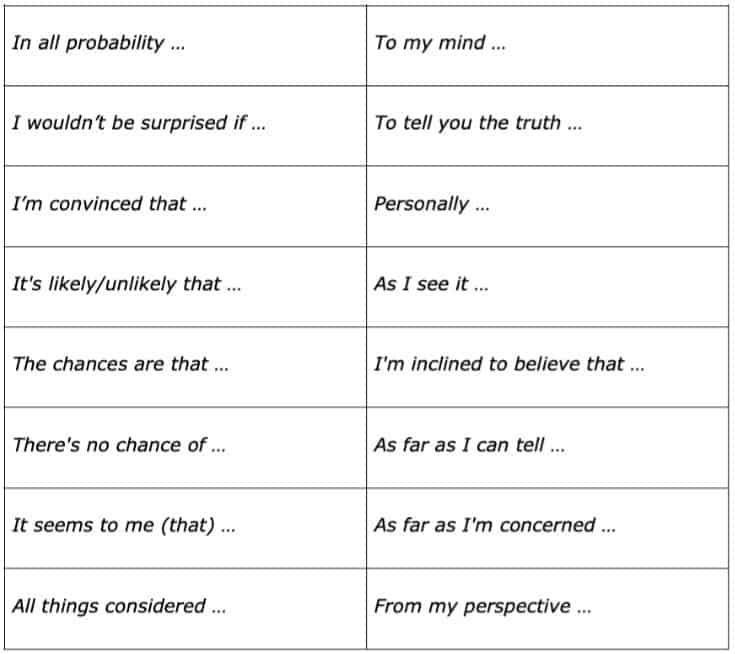
Tip 4 – Know your second conditional inside out
As some of the example questions above show, it’s possible that you’ll have to speculate about the future with some of your answers.
Therefore, I recommend you to know the second conditional structure inside out:

Q – Can you tell us something about your plans for the future, in terms of work?
A – I’m passionate about technology. If I had the chance, I’d really like to work for Apple. I have an intense work ethic and an eye for creation and innovation so I think I’d really fit in there at Apple.
Tip 5 – Keywords and collocations – but not monologues!
CPE examiners are savvy enough to know when a candidate’s producing a rehearsed answer.
The whole idea of the exam is to see how natural you sound and how well you manage your emotions and language skills in an impromptu, real-life situation.
Hence, you’d be well-advised to learn some C2-level vocabulary and phrases which you can use for the types of questions the interlocutor might ask you.
Let me come up with an appropriate stock of words and phrases which complement two of the sample questions I shared with you earlier:
Could you tell us something about why you are learning English?
Describing the English language and one’s need/passion to learn it:
job opportunities, job prospects, age of globalisation, become more internationalised, boost confidence, stand out, intellectual challenge, touristic purposes, access to multiple cultures
What do you like about the area you live in?
Describing local areas:
secluded, amenities, facilities, leafy, vibrant, family-friendly, modern, traditional, well-connected, centrally located, just a stone’s throw from the XXX, within easy reach of XXX, outskirts, suburban
Tip 6 – You don’t have to speak to get a better grade
Based on several CPE speaking exams I’ve watched online, it’s clear to me that some candidates simply ‘switch off’ when it’s not their turn to talk in part 1 of the exam.
I believe that examiners pick up on the non-verbal communication displayed by the candidate who’s not speaking.
It’s no good staring intently at the examiner. Many candidates also stare at the ceiling, or at the desk. Or, they just look plain bored.
Remember that these examiners are human. They are sensitive to body language and facial expressions.
Regardless of how nervous you are, you need to look at your fellow candidate(s) and listen to their answers. The odd smile and nod of the head won’t do any harm either.
Part 2: COLLABORATIVE TASK
Task type and format
Part 2 of the CPE speaking exam requires you and your partner to talk together. The stimulus for the ensuing discussion is visual (one or several photographs). The interlocutor will lay out these photographs on the table in front of you.
Activity 1
Firstly, the interlocutor will ask you a question which aims to hone in on your reaction to elements of a maximum of two pictures.
Time allowed – 1 minute
Example task for activity 1:
With reference to a task I found on esl-lounge.com, here’s a flavour of what activity 1 looks like in reality.
Interlocutor:
First, I’d like you to look at photograph 1 and tell me how common a situation like this is in your own country.

Activity 2
After roughly one minute, the interlocutor will give both of you a decision-making task based on all of the pictures.
Here are the remaining pictures from the practice test on esl-lounge.com:



Interlocutor:
Thank you. Now look at all the pictures.
I’d like you to imagine that you need to select one of these pictures for the cover of a book titled ‘Back to Nature’.
Talk together and decide which of these pictures would be the most suitable cover photo. Explain why the other photos are not appropriate.
You have about three minutes to talk about this.
‘Interactive communication’ is the name of the game
I’ll go over the overall CPE speaking assessment scales and marking criteria a little later on. However, I think it’s worth taking a look at the ‘Interactive Communication’ scale now because it’s relevant to part 2. This criterion is worth 13.3% of a candidate’s overall mark.

Interpreting Cambridge’s demands when it comes to ‘Interactive communication’
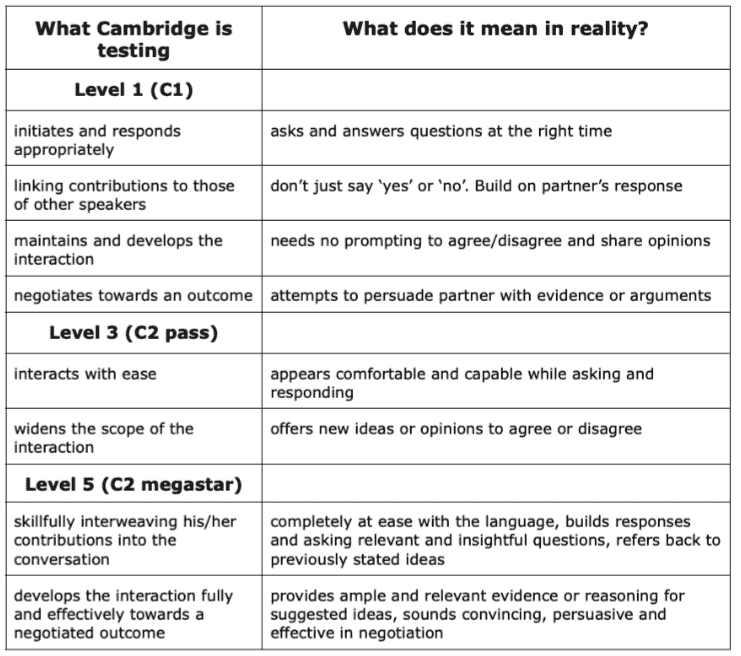
As you can see in the table above, what really separates CAE (C1) from CPE (C2) is the ability to ‘widen the scope of the interaction’.
At C1 level, there’s more of an emphasis on accuracy, something which neutralises a candidate’s ability to be completely natural with their use of English.
Conversely, at C2 level, you should be able to show the examiners how comfortable you are with your use of English. Indeed, you’re required to exploit the photos and requirements of the task by adding fresh ideas and expanding on the topic to allow true discussion and debate to flourish.
What skills does part 2 test exactly?
- initiating and sustaining an interaction;
- exchanging ideas;
- expressing and defending points of view;
- agreeing/disagreeing;
- suggesting;
- evaluating;
- speculating;
- negotiation which leads to a decision.
What phrases can you use to ‘collaborate’ and communicate interactively?
As the saying goes, ‘variety is the spice of life’. Saying “I agree” or “I disagree” every time your partner says something will not score you many points. Hence, here are some emphatic alternatives:
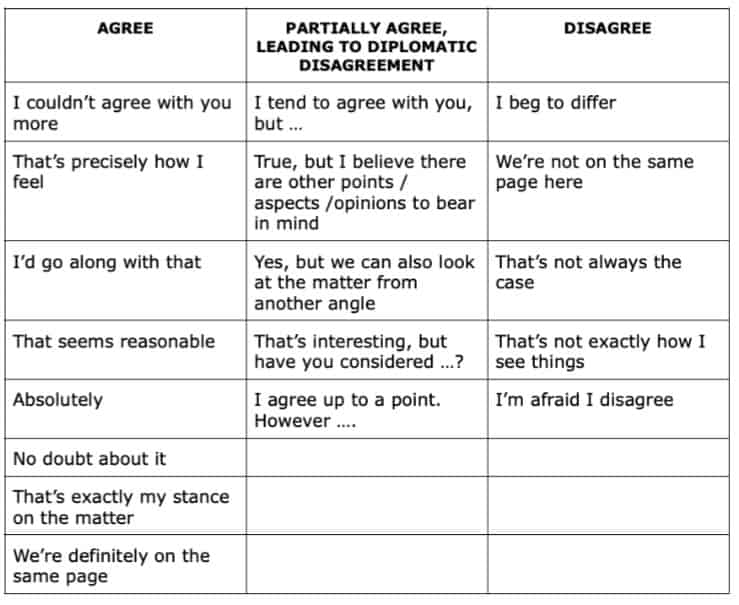
Top tips for acing part 2 of the CPE speaking exam
1. Don’t worry if your partner is introverted or nervous
There might be a temptation for you to become frustrated if you have to deal with an introverted/nervous partner. However, you are the master of your own destiny. Don’t worry about this kind of partner negatively affecting your marks:
- CPE-level interactive communication revolves around ‘interacting with ease’ and ‘widening the scope of interaction’. These skills are both achievable, even if your partner is only barely responsive;
- Ensure that you give your partner the OPPORTUNITY to speak. It’s down to them if they take advantage of this opportunity or not;
- In summary, ask your partner plenty of questions, bring in some of your own ideas and respond to what they say, even if their statements lack substance or detail. If you stick to this plan, it will be more than adequate to score 3+.
2. Don’t be too concerned if your partner is clearly below the C2 level
As with the previous situation regarding introverted candidates, having a partner who clearly isn’t prepared for CPE should not be of your concern. There’s no way that their performance can have an influence on your grade.
Be human. Even if you can see they’re struggling, allow them to have their say. Don’t interrupt them.
3. Don’t show your frustration if you get paired up with a domineering partner
It often happens that a candidate feels compelled to dominate the discussion.
Here’s why you shouldn’t let your frustration boil over if are lumbered with a domineering candidate:
- Your partner will be penalised for not letting you get a word in edgeways;
- Correspondingly, if you make a genuine attempt to contribute, you won’t be penalised;
- CPE interlocutors are trained to allow both candidates to speak for roughly an equal amount of time
Is there anything wrong with politely interjecting if you sense that your partner’s dominating the discussion? I don’t think so. Why not jump in with one of the following phrases:
- Is it okay if I jump for a moment?
- Could I make a suggestion?
- If I might add something …
4. Ask for clarification if required
Don’t be afraid to ask the interlocutor, or your partner, for clarification if you forget what you have to do. For instance, you don’t want to describe too many photos, or the wrong photos, in the first activity. Just ask – it’s better to be safe than sorry.
5. Pay attention to the title on the visuals sheet
In part 2, take notice of the title on the visuals sheet. Firstly, doing this will help you to remember the interlocutor’s instructions. Secondly, the information provided in the title regarding the context or audience (e.g. Magazine article) will enable you to keep the discussion focused.
Part 3 – LONG TURN AND DISCUSSION
Task type and format
The final part of the CPE speaking exam tests your ability to build and sustain discourse (long turns), and to engage in discussion on the themes of the long turns.
In addition to organising a longer speech, this part of the exam also tests your ability to express and justify points of view.
(a) Procedure for the Long Turn
- The interlocutor says something along the lines of:
Now, in this part of the test you’re each going to talk on your own for about two minutes. You need to listen while your partner is speaking because you’ll be asked to comment afterwards
- The interlocutor informs Candidate A that they will be given a card with a question on it and they have to say what they think;
- Candidate A is also informed that there are some ideas on the card which they can use should they so wish;
- The interlocutor places the card – Task 1(a) – in front of Candidate A;
- Candidate A should let Candidate B see the card;
- The interlocutor reminds Candidate A that they have roughly two minutes to talk before they’ll be interrupted;
- Candidate A may gather their thoughts for 10 seconds before the interlocutor asks them if they’d like to begin;
- After two minutes, the interlocutor asks one of several questions to Candidate B;
- The interlocutor invites Candidate A to join in again by referring to a prompt such as What do you think?
Example task for Part 3 – long turn
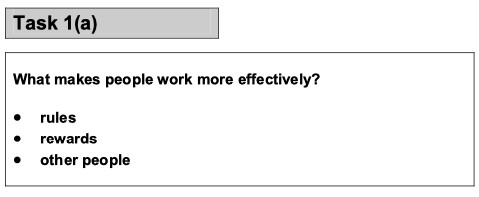

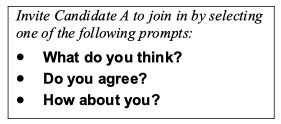
Top tips for acing the Long Turn
1. Don’t rush in at the start
As previously stated, you can allow yourselves up to 10 seconds before you start speaking. It might also be useful to read the question out loud to get yourself going.
2. Keep THREE things in mind when structuring extended speech
-
the use of linking words and devices
– although, even if, in spite of the fact that …, besides, consequently -
counter-argument
– While it may be true that…, A possible concern is… , I agree/admit/concede that… but we must remember that… -
summing up
– to recap, to summarise, all in all, in a nutshell
3. Focus on the structure of your answer
Don’t try to squeeze in everything you know about a topic in 2 minutes.
It’s vital to focus on the structure of your response. Namely, you need to include an introduction, main arguments and a conclusion – just like you would in an essay.
CPE Long Turn: Thorough analysis
* Check out this fabulous article which focuses on four audio recordings from genuine candidates taking the CPE exam. Experienced teacher and examiner, Helen Ingram, provided the feedback and analysis.
(b) Discussion
Now, the final activity of the CPE speaking exam – the discussion.
In general, candidates have to handle some general questions related to the theme of the Long Turn questions.
The questions may be asked to a certain candidate or they may be left open for either partner to respond first. Logically, you should take it in turns with your partner to be the initial responder.
Sample task
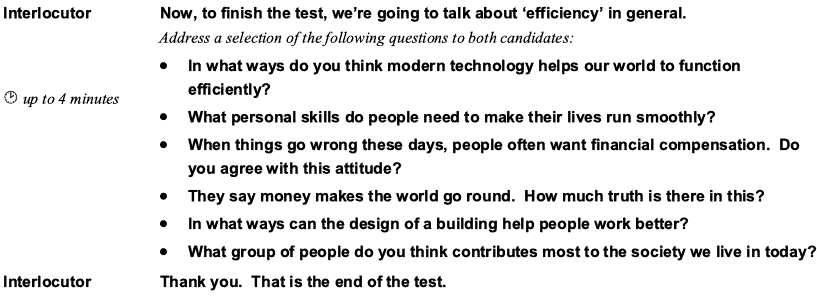
Top tips for acing the discussion
1. It’s more vital than ever to pay attention
You will be required to reflect on your partner’s contributions. Hence, it’s vital that you pay attention to what he/she says.
2. Abstractness over personalisation
It’s important that you talk about the topic at hand in an abstract way rather than talking about yourself and your own experiences. If a question begins ‘In what ways …’, then it’s a sign that you shouldn’t waffle on about yourself.
How is the CPE speaking exam marked?
The interlocutors will assess you based on your own individual performance. The majority of the marks are awarded by the assessor. However, the interlocutor awards a mark for global achievement.
Assessment for C2 Proficiency is tied to a candidate’s performance across all parts of the test. The final mark is achieved by applying the relevant descriptors in the assessment scales. Here’s a summary of the speaking criteria and an indication as to how the examiners mark the test:
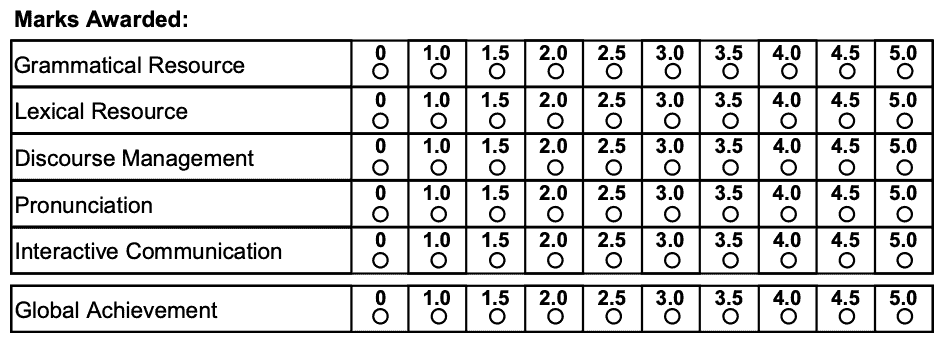
Now, even more detail. The interlocutor gives a mark of 0-5 for Global Achievement. This mark is subsequently multiplied by five. The assessor gives marks of 0-5 for all of the other criteria. Marks for each of these criteria are doubled.
Overall, there are 75 marks available in the Speaking test.
To get a C2 mark in the CPE speaking exam, you will need to gain at least 45 marks. Check out the table below:
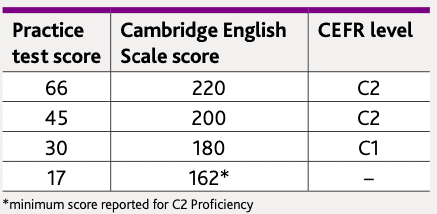
Criteria and descriptors
Do you remember that I covered ‘Interactive Communication’ earlier on in the post? This criteria is worth 13.3% of your overall mark.
After a short note, let’s take a look at the other five assessment scales, together with their descriptors, in more detail:
NOTE: C2 Proficiency Speaking Examiners use a more detailed version of the following assessment scales. However, I don’t see the need to reveal the scales for levels A1-B2.
1 – FAIL (C1)
3 – PASS (C2)
5 – SUPERSTAR (C2)
Grammatical Resource [13.3%]:
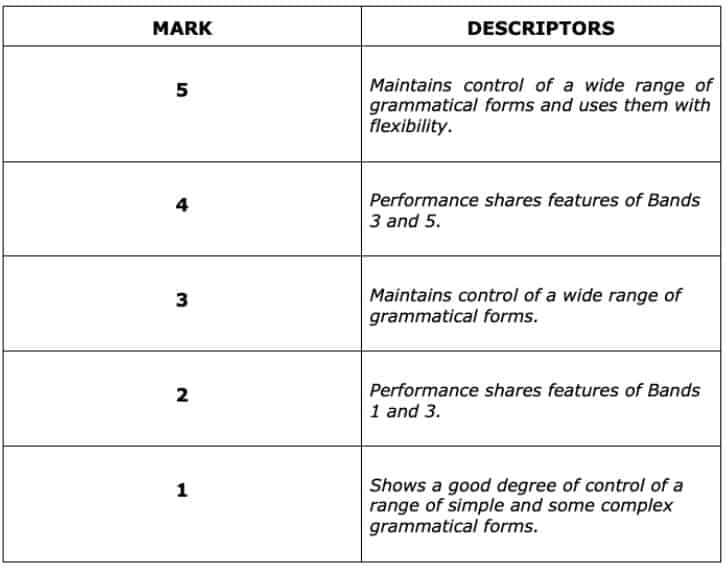
Comments on the Grammatical Resource scale:
- Simple grammatical forms – past and present tenses, first and second conditionals, simple and continuous future tenses;
- Complex grammatical forms – third conditional, inversion, relative clauses, passive structures, modal forms.
Lexical Resource [13.3%]:
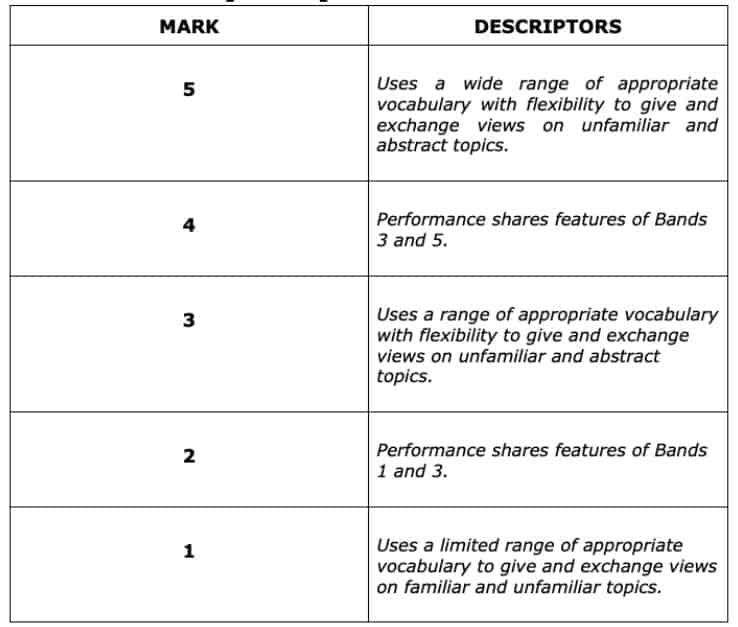
Comments on the Lexical Resource scale:
- Appropriacy of vocabulary – using words and phrases which suit the context of the given task. For instance, you shouldn’t say “There was big rain this morning which made it impossible to commute to work on time”. It’s more appropriate to say “There was HEAVY rain this morning which made it impossible to commute to work on time”;
- ‘Appropriate’ for the context – ‘commute to work’ is an excellent choice when it comes to the topic of transport/travel in a city;
- ‘Appropriate’ in terms of correctness – ‘heavy rain’ not ‘big rain’;
- ‘Flexibility’ – the ability of candidates to adapt the language they use in order to give emphasis, to differentiate according to the context, and to exclude ambiguity. An example of this would be paraphrasing ideas;
- ‘Range’ – to do with variety. If flexibility refers to being able to give extra information with lexis, range describes your ability to use synonyms for accuracy and style;
- ‘Wide range’ – the examiners wish to hear collocations, phrasal verbs and one or two idioms to show that you’re comfortable and familiar with English;
- ‘Limited range’ – the candidate uses phrases, adjectives and nouns which lower level learners typically use e.g. cold and very big;
- ‘Abstract topics’ – topics which include ideas as opposed to concrete situations or events. C2 Proficiency tasks demand candidates to discuss to what extent the development of our civilisation has been affected by chance discoveries or events, for example.
Discourse Management [13.3%]:
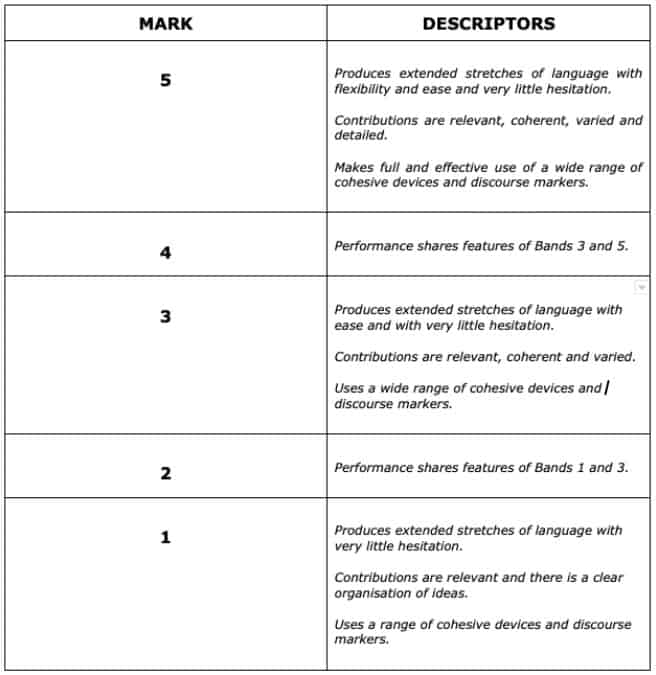
Comments on the Discourse Management scale:
- Coherence – Broadly speaking, coherence refers to a clear and logical stretch of speech which can be easily followed by a listener;
- Cohesion and coherence – If coherence refers to being logical and easy to follow for the listener, then cohesion deals with how to achieve a state of coherence. Cohesion and coherence can be achieved in a plethora of ways. Here are four methods:
-
Cohesive devices:
These are words or phrases which show relationships between utterances. For example, consequence (so, as a result, therefore); order of information (first, second, third, next, finally); addition (and, in addition, moreover)
-
Related vocabulary:
Being able to correct retrieve multiple items from the same lexical set, e.g. study, learn, repeat, revise, cram
-
Grammatical devices:
These devices essentially refer to reference pronouns (e.g. it, this, one) and articles (the, a)
-
Discourse markers:
Discourse markers are words or phrases which are mainly used in spoken English. They add meaning to the interaction and sound completely natural (e.g. actually, I mean, well)
Pronunciation [13.3%]:
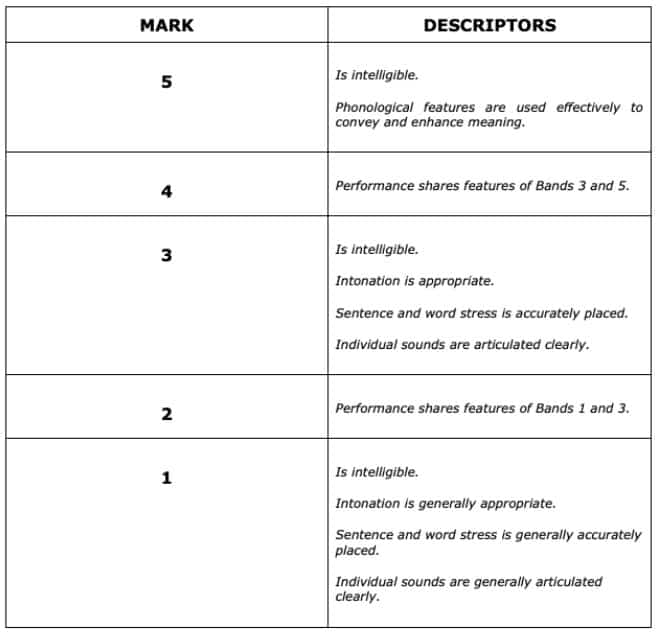
Comments on the Pronunciation scale:
- ‘Intelligible’ – a contribution which a non-EFL/ESOL specialist can understand, irrespective of whether the speaker has a strong or unfamiliar accent.
- ‘Phonological features are used effectively to convey and enhance meaning’ [BAND 5] – being able to convey arguments and information through intonation whereby stress falls on appropriate words in a sentence (i.e. sentence stress)
Global Achievement [33.3%]:
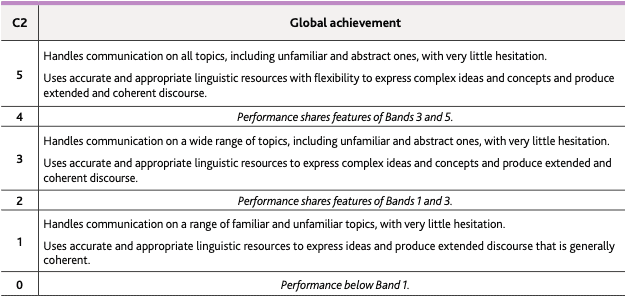
How to best prepare for the CPE speaking exam?
It’s been a long road to reach the final section of this post. However, here are my tips on what you need to do to be fully prepared for the CPE speaking exam.
1. Analyse a real C2 Proficiency Speaking Test
When you search for ‘CPE speaking exam’ on Youtube, the test with Rodgrigo and Ollin will appear somewhere near the top of the list:
I won’t analyse the test myself because Cambridge has already provided an assessment commentary.
2. Make use of transcripts of recordings and take note of useful language
Transcripts of spoken English contain a plethora of colloquial expressions and chunks of language which can boost your own spoken performance.
Where can you find these transcripts?:
- CPE coursebooks;
- TED talks (not strictly conversational dialogue, but still very useful nonetheless);
- Corpora – check out the Santa Barbara Corpus of Spoken American English, for example. You can listen to recordings of naturally occurring spoken interaction and read the transcript at the same time;
Now, let’s move on to how you can record these useful chunks of language.
3. Create a Word-Phrase Table for all the useful chunks of language you come across
I’ve written about the Word-Phrase Table extensively on this website. Frankly, this language learning strategy helped me to elevate my speaking level of the Serbian language to C1 level in no time.
I’ve just found the collocation concerted effort in a tapescript for a sample CPE Listening Test. Check out page 45 of the latest C2 Proficiency Handbook for Teachers. Click on the link at the top of that page to download the audio files.
Here’s an utterance made by ‘M’ in extract two:

Personally, I think concerted effort might be a useful collocation when it comes to giving opinions in parts 2 and 3 of the speaking exam.
** Definition of concerted – a determined action that’s been planned or devised by several people or groups working together
So, in a table on a google doc, I’d add concerted effort in the left-hand column:
![]()
After dashes, I could add some grammatical structures and other phrases which may precede or succeed concerted effort. Moreover, I could add similar phrases which contain the word concerted after the + symbol:

The most vital stage is to add personalised sentences after a star (*). By personalised, I mean sentences that represent genuine life experiences, your current situation or personal opinions.
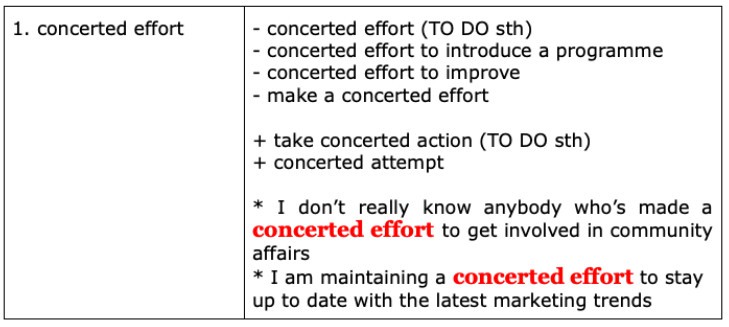
Inevitably, there may not be an appropriate opportunity to use these personalised sentences in your CPE speaking exam. However, the point is to make sure you can effortlessly retrieve the target collocation (concerted effort) and surrounding structures.
With regular revision and silent reading of these sentences, you’ll find that they’re ‘swimming in the brain’. This, I believe, is the essence of fluency – having personalised sentences and chunks of language running around your mind when interacting with others.
For visual memory purposes, you may use different colours, italics and bold in your table to make key collocations and chunks of language stand out.
Check out some other methods to memorise English vocabulary in this post.
References
https://www.cambridgeenglish.org/images/210434-converting-practice-test-scores-to-cambridge-english-scale-scores.pdf
https://www.cambridgeenglish.org/Images/610343-c2-proficiency-information-for-candidates.pdf
https://www.cambridgeenglish.org/exams-and-tests/proficiency/preparation/
https://www.caeexamtips.com/blog/cpe-long-turn-in-depth-analysis
https://www.englishadam.com/CPE-Proficiency-Speaking-Criteria















![Toni Kroos là ai? [ sự thật về tiểu sử đầy đủ Toni Kroos ]](https://evbn.org/wp-content/uploads/New-Project-6635-1671934592.jpg)


